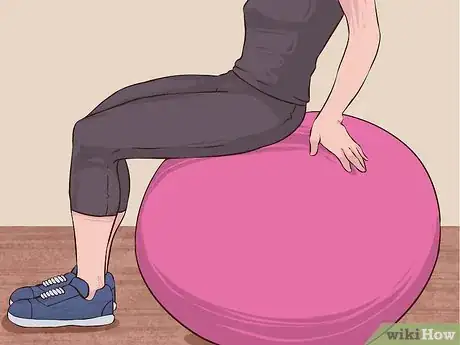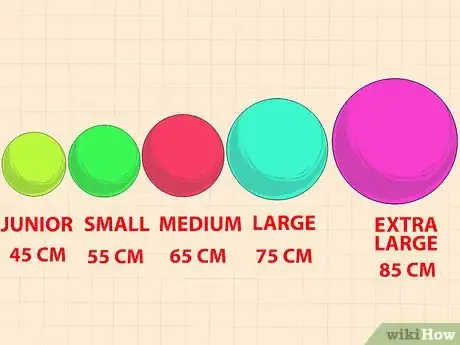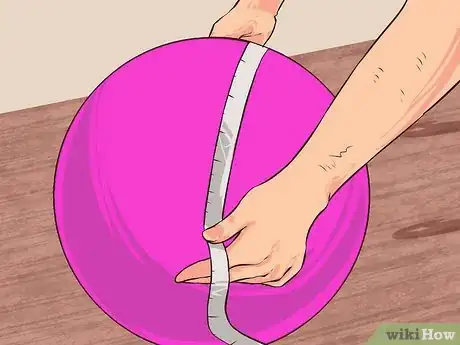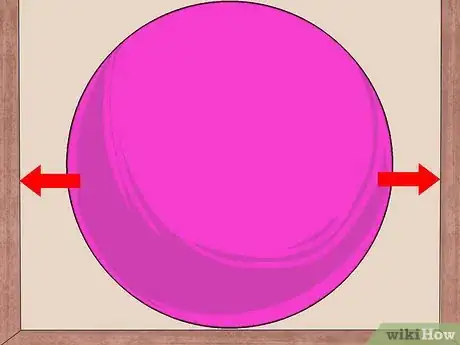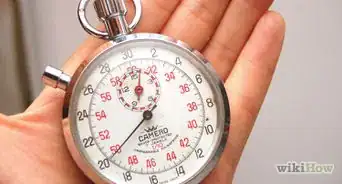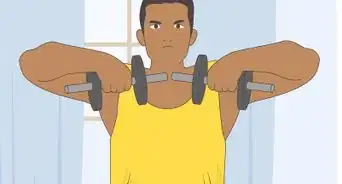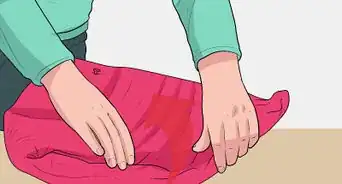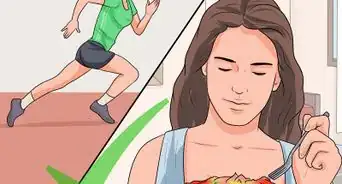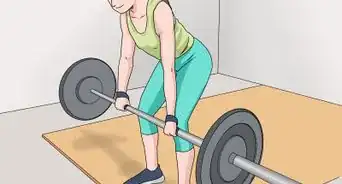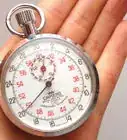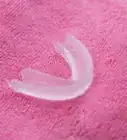This article was co-authored by Katie Dunlop. Katie Dunlop is a Certified Personal Trainer, Sports Nutritionist, and the Founder of Love Sweat Fitness. She specializes in helping others with nutrition, fitness, and lifestyle choices. Katie has also developed LSF Nutrition, a nutrition supplement line, and a mobile workout application, Love Sweat Fitness The App. With her platform and tools, she has helped over one million women and has been featured in publications such as Women’s Health, Shape, and Health.
wikiHow marks an article as reader-approved once it receives enough positive feedback. In this case, several readers have written to tell us that this article was helpful to them, earning it our reader-approved status.
This article has been viewed 198,309 times.
Fitness balls are great exercise tools used for core training, yoga, Pilates, as stretching aids and more. But in order to establish the right leverage for each exercise or stretch, the ball must be the right size for your body. Knowing your fitness ball's size and regularly checking its inflation level will help you stay safe while getting the most out of your workout.
Steps
Measuring With Your Body
-
1Sit down on the fitness ball. Distribute your weight evenly and keep your feet flat on the floor. If the ball’s the right size for you, your hips and knees should both be bent at about 90 degrees, and your thighs should be horizontal.[1]
- Your upper body should be vertical with your ears, shoulders and pelvis aligned. Don’t lean in any direction to avoid creating a counterbalance.
-
2Check for proper compression. It's not enough for the ball to fit your body; it also needs to be properly inflated. A properly inflated fitness ball should compress about 6 inches when you sit on it.
- If the ball fits your body but compresses more than 6 inches beneath you, it's not the right size ball for you; it's a larger ball that's been under-inflated. You can exercise on such a ball, but may find that the extra-soft ball feels awkward and makes balancing too easy.
- Don't over-inflate a smaller ball to make it fit your body; the extra pressure makes it more likely to burst.
- When fully inflated, you should be able to press 2” into the fitness ball with your finger.
- Fitness balls lose pressure with use and age. As your ball ages, you may need to inflate it more often.
Advertisement -
3Check a sizing chart. Manufacturers provide fitness ball sizing charts that correlate ball diameter with body height. These are only estimates and vary widely between the various ball manufacturers. Give how the ball actually fits your body higher priority than the sizing charts.
- You may be able to successfully use a smaller or larger sized fitness ball as you gain experience.
- The size of the exercise ball depends on your height and the exercises you plan to do with it.[2]
- Usually, if you are between 5 feet to 5 feet 9 inches tall, you should use a ball around 55cm.[3]
- When you do a dumbbell press on an exercise ball, ensure that your feet can touch the ground firmly.[4]
Using Measuring Tape
-
1Wrap a flexible measuring tape all the way around the inflated fitness ball. Some fitness balls have concentric rings marked around the ball; use the widest of these rings around the ball's “equator” to help you align the tape correctly.
-
2Measure the circumference of the fitness ball. Fitness ball sizes are listed in diameter (the distance straight from one side of the sphere to the opposite side, passing through the center), not circumference. Divide the circumference by pi, or 3.14, to get the diameter.
- For example, if your ball has a circumference of 172 centimeters, its diameter is 172 / 3.14 = 55cm.
- Your exercise ball may stretch up to 24 hours after you inflate it. Measure your fitness ball when it’s fully inflated to ensure it’s the right size for your body.
-
3Convert your measurement. Fitness ball sizes are always measured in centimeters, even in countries that usually use Imperial measurements. If you measured in inches, you'll need to make the appropriate conversion.
- The most common ball sizes, translated to centimeters and rounded up to the nearest inch, are: 45cm = 18 inches, 55cm = 22 inches, 65cm = 26 inches, and 76cm = 30 inches.
Measuring With a Wall
-
1Check the ball's packaging for the ball's intended diameter. If you don't have the ball's packaging, check the ball itself; the intended size is often printed near the air valve or on the ball's "equator."
-
2Place a large box away from the wall at a distance equaling the ball’s diameter. Use a yardstick or tape measure and make sure this distance is exact. The box you use should measure at least as high as your fitness ball.
-
3Roll the ball between the box and the wall. If it passes through without brushing either, it's underinflated. When correctly inflated, the edges of the ball should just graze the box and the wall.
- If you don't know the ball's intended diameter but need to know its actual size, place the ball against the wall. Position the box so that it just touches the opposite side of the ball. Then remove the ball, and measure from the box to the wall to calculate the ball's diameter.
-
4Measure the height of your fitness ball against a wall. Alternatively, you can use your ball’s height to determine whether it’s inflated correctly. Use painter’s tape and make a mark on your wall at the same height as the fitness ball’s diameter. Then, inflate your fitness ball until it’s level with this mark.
- The diameter of your fitness ball is the same as its height. [5]
Expert Q&A
-
QuestionHow should you sit on a yoga ball at work?
 Susana Jones, C-IAYTBased in San Diego, Susana Jones is a Yoga Therapist and Educator with 12 years of experience serving groups, individuals and organizations. She is certified with the International Association of Yoga Therapists, registered as an E-RYT 500 with Yoga Alliance and holds a Bachelor’s degree from the University of Colorado. Susana offers therapeutic yoga to private clients through Shakti Urbana and mentors students of the internationally accredited Soul of Yoga. Susana dedicates her work to peaceful living on a healthy planet.
Susana Jones, C-IAYTBased in San Diego, Susana Jones is a Yoga Therapist and Educator with 12 years of experience serving groups, individuals and organizations. She is certified with the International Association of Yoga Therapists, registered as an E-RYT 500 with Yoga Alliance and holds a Bachelor’s degree from the University of Colorado. Susana offers therapeutic yoga to private clients through Shakti Urbana and mentors students of the internationally accredited Soul of Yoga. Susana dedicates her work to peaceful living on a healthy planet.
Certified Yoga Therapist & Educator By just sitting on that yoga ball doing regular things as one works from home or at the office, can help redistribute one's center of gravity from side to side on a spherical object can help stabilize your core muscles and sides. This can then translate well into one's yoga practice if they're going deeper into that postural yoga realm or just increasing their sense of well-being by feeling stable and fit in general.
By just sitting on that yoga ball doing regular things as one works from home or at the office, can help redistribute one's center of gravity from side to side on a spherical object can help stabilize your core muscles and sides. This can then translate well into one's yoga practice if they're going deeper into that postural yoga realm or just increasing their sense of well-being by feeling stable and fit in general.
Things You'll Need
- Flexible tape measure
- Large box
- Painter's tape
References
- ↑ http://www.spine-health.com/wellness/exercise/choosing-right-exercise-ball
- ↑ Katie Dunlop. Certified Personal Trainer & Sports Nutritionist. Expert Interview. 25 August 2021.
- ↑ Katie Dunlop. Certified Personal Trainer & Sports Nutritionist. Expert Interview. 25 August 2021.
- ↑ Katie Dunlop. Certified Personal Trainer & Sports Nutritionist. Expert Interview. 25 August 2021.
- ↑ http://life.gaiam.com/article/top-10-balance-ball-exercise-ball-stability-ball-faqs
About This Article
To measure a fitness ball, start by getting a flexible measuring tape that will fit all the way around the ball. Then, measure the circumference of the ball and divide this by 3.14 to calculate the diameter, making sure to convert to centimeters. Another way to measure a fitness ball is using your body and sitting on the ball with your feet flat on the floor. If you have the right size, your hips and knees should be bent at a 90 degree angle. For more advice, like how to check if your ball is properly inflated, keep reading!
